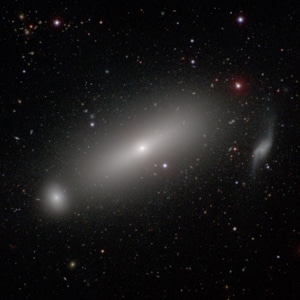May 9 2016
The mass of a supermassive black hole sitting at the heart of a galaxy called NGC 1332 has been measured with unprecedented accuracy by a group of international researchers that includes Andrew J. Baker, an associate professor at Rutgers University.
 This is NGC 1332, a galaxy with a black hole at its center whose mass has been measured with high precision by ALMA. (Photo: Carnegie-Irvine Galaxy Survey)
This is NGC 1332, a galaxy with a black hole at its center whose mass has been measured with high precision by ALMA. (Photo: Carnegie-Irvine Galaxy Survey)
This black hole has a mass of roughly 660 million times more than that of our sun, with a cloud of gas circling at a speed of around 1.1 million mph. It is located at a distance of 73 million light years from our planet.
The researchers used the state-of-the-art Atacama Large Millimeter/submillimeter Array (ALMA) telescope in Chile to make the breakthrough observations. ALMA is considered as the largest astronomical project in the world. The telescope consists of 66 radio antennas at approximately 16,400 feet above sea level.
The study results have been reported in the Astrophysical Journal Letters.
Supermassive black holes are generally present at the hearts of galaxies. They have enormous density and gravity and therefore, anything that is in their proximity, including light, is pulled in by them, explained Baker, an associate professor in the Astrophysics Group in the Department of Physics and Astronomy of the Rutgers University. The department is located in the School of Arts and Sciences.
Black holes can be formed subsequent to the condensation of matter, often obtained from an exploding star, by gravity. Supermassive black holes located at the hearts of massive galaxies evolve by swallowing stars, gas, and other black holes. However, said Baker, “just because there’s a black hole in your neighborhood, it does not act like a cosmic vacuum cleaner.”
Stars that are moving rapidly and in stable orbits won’t be swallowed by the black hole even if they come close to it, said Baker, who has been serving at Rutgers since 2006.
The black hole at the center of the Milky Way, which is the biggest one in our own galaxy, is many thousands of light years away from us. We’re not going to get sucked in.
Andrew J. Baker, Associate Professor, Rutgers University
Researchers believe that a massive black hole is present at the center of every massive galaxy such as the Milky Way, informed Baker.
The ubiquity of black holes is one indicator of the profound influence that they have on the formation of the galaxies in which they live.
Andrew J. Baker, Associate Professor, Rutgers University
Modern astrophysicists are striving to gain knowledge about galaxy formation and evolution. The new findings could help understanding the formation of galaxies and their supermassive black holes. The ratio of the mass of a black hole to the mass of its galaxy is crucial to know about their makeup, Baker said.
According to the study, there is coordination between the evolution of black holes and the evolution of their galaxies. Therefore, it is necessary to gain knowledge about supermassive black holes to discover the formation and evolution of their galaxies, explained Baker.
Measuring the mass of supermassive black holes accurately is one way that allows researchers to determine whether the growth rate of a black hole is higher or lower than its galaxy. Any definitive conclusions cannot be drawn by scientists if mass measurements of black holes are erroneous, said Baker.
The researchers used ALMA’s high-resolution data of carbon monoxide emissions from a massive disc of cold gas circling the black hole for measuring the mass of the central black hole of NGC 1332. The speed of the gas was also measured by the researchers.
This has been a very active area of research for the last 20 years, trying to characterize the masses of black holes at the centers of galaxies. This is a case where new instrumentation has allowed us to make an important new advance in terms of what we can say scientifically.
Andrew J. Baker, Associate Professor, Rutgers University
Recently, Baker and his coauthors put forward a proposal to utilize the ALMA telescope for supermassive black hole observation. They received the approval for use of ALMA following a yearly international competition of proposals.
ALMA is a global collaboration of the National Radio Astronomy Observatory, National Astronomical Observatory of Japan, and European Southern Observatory, in cooperation with the Republic of Chile. US access to ALMA comes through the National Science Foundation-supported National Radio Astronomy Observatory.
Coauthors of the study of are lead author Aaron J. Barth, Benjamin D. Boizelle and David A. Buote of the University of California, Irvine; Jeremy Darling of the University of Colorado; Baker; Luis C. Ho of the Kavli Institute for Astronomy and Astrophysics at Peking University in Beijing, China; and Jonelle L. Walsh of Texas A&M University.